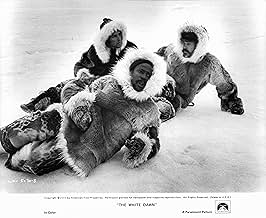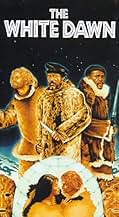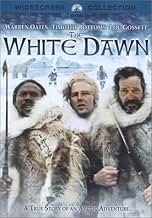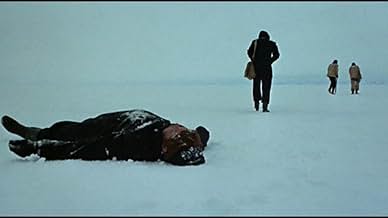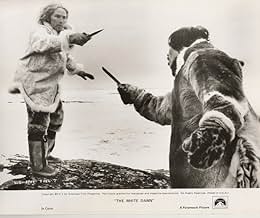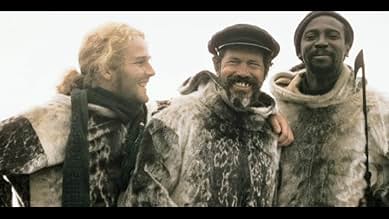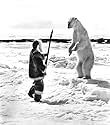In 1896, three survivors of a whaling ship-wreck in the Canadian Arctic are saved and adopted by an Eskimo tribe but frictions arise when the three start misbehaving.In 1896, three survivors of a whaling ship-wreck in the Canadian Arctic are saved and adopted by an Eskimo tribe but frictions arise when the three start misbehaving.In 1896, three survivors of a whaling ship-wreck in the Canadian Arctic are saved and adopted by an Eskimo tribe but frictions arise when the three start misbehaving.
Louis Gossett Jr.
- Portagee
- (as Lou Gossett)
Ann Meekitjuk Hanson
- Neevee
- (as Pilitak)
Featured reviews
This little-known film of Philip Kaufman's is a look at a culture not seen much in films, that of the Innuit, or Eskimo people of Arctic Canada. Three whalers (Warren Oates, Timothy Bottoms and Louis Gosset Jr.) are stranded among them after a shipwreck. The year is 1896 but it could just as well be 1996 or 1796 as far as we can tell in this simple world where survival against nature is always the biggest concern. Surprisingly to me, the culture clash does not seem to be that great through most of the movie, and when it comes, it does so rather quickly. I think this makes for a less strong film but it's still an interesting one that really fascinates at times.
Cinematographer Michael Chapman ('Raging Bull') provides some great shots of the Great White North and Henry Mancini's score is very nice also. Martin Ransohoff is usually known as a producer but co-wrote the script here with Thomas Rickman.
Cinematographer Michael Chapman ('Raging Bull') provides some great shots of the Great White North and Henry Mancini's score is very nice also. Martin Ransohoff is usually known as a producer but co-wrote the script here with Thomas Rickman.
It's 1896 in the Artic. Four whalers are stranded when their small hunting boat runs into ice and their ship fails to find them. Billy (Warren Oates), Daggett (Timothy Bottoms), and Portagee (Louis Gossett Jr.) leave behind their dead comrade and get rescued by passing Inuits. The Inuits see them as Dog-Children.
The Inuit culture seems authentic. There is a realism in the people and their way of life. The main drawback is the three survivors. They are not appealing characters. One of them needs to be heroic but the opening already lays bare that aspiration. Daggett and Portagee readily abandons a weaken Billy to die in the open. At least, Daggett should go back and try to comfort Billy. It's the same for their ship which searched for only a day or so for their missing crew. It portrays a western culture of personal greed and its corrupting influences. It doesn't mean that the Inuit culture is an utopian one. It is still very much a human world with its own villain. I simply didn't like the characters which detracts from my enjoyment of this film. I wish I like Daggett more.
The Inuit culture seems authentic. There is a realism in the people and their way of life. The main drawback is the three survivors. They are not appealing characters. One of them needs to be heroic but the opening already lays bare that aspiration. Daggett and Portagee readily abandons a weaken Billy to die in the open. At least, Daggett should go back and try to comfort Billy. It's the same for their ship which searched for only a day or so for their missing crew. It portrays a western culture of personal greed and its corrupting influences. It doesn't mean that the Inuit culture is an utopian one. It is still very much a human world with its own villain. I simply didn't like the characters which detracts from my enjoyment of this film. I wish I like Daggett more.
I saw this film last year at the Chicago International Film Festival with Philip Kaufman and Prof. Annette Insdorf presenting and I was totally blown away. It is both a beautiful love story between a white man and an Inuit woman and a big, spectacular adventure film. There are some amazing scenes, one involving polar bear (this scene alone is amazing and worth seeing the film for) , seal hunting, walrus hunting, boating in the treacherous ice-floes, etc. The performances are excellent from Timothy Bottoms , Warren Oates, Louis Gosset, Jr. and the wonderful actors of the Inuit community. The film continually takes your breath away and has some of the most beautiful love scenes I've ever seen. It's apparently based on a true story of the first encounter of the Inuit with the Dog Children (us). The film has some heartbreaking scenes (which I won't discuss) and the acting by the untrained Inuit actors is truly spectacular. I can't recommend this film enough.
have some respect for and knowledge of tribal cultures where the shamans have authority, the people are "tuned in" to the natural world, and "nature magic" is understood on a gut level by everyone from childhood onward. I saw this film many years ago and loved it; it's still excellent. If you like it, you may want to read "The Heart of the Hunter" by Laurens Van Der Post, a classic about the Bushmen in South Africa. This film will be of value to anyone who has someone in their family who's made a mess of his or her life because of alcohol. Grab the drinker and make him or her watch it and that person may get a sense for how destructive that behavior is. Anyone who wants to learn about the Bear Spirit will learn something here as well.
Looking back from the 21st century, it is obvious that from the moment Columbus set foot in the new world the indigenous peoples of the Americas were doomed. It is equally obvious to a thoughtful viewer from 2005 that a movie made in 1973 about three shipwrecked whalers who are rescued by a band of Inuit and the resulting culture clash is going to end in tragedy. I knew the conclusion of "The White Dawn" as soon as I read two sentences of it's description on Netflix.
But we shouldn't really hold that against it. Because "The White Dawn" is a very good movie and I am shocked that more movie aficionados haven't heard of it. I never did, and I am a fan of Philip Kaufman and Timothy Bottoms and movies of the 70s, and I have an interest in the arctic. This movie seems to have been buried under a rock somewhere, despite fine performances all around, beautiful cinematography and direction, and fascinating subject matter in the Eskimos.
Filmed on location on Baffin Island in what is now Nunavet, the Inuit territory of Northern Canada, "The White Dawn" portrays the story of the three whalers - Timothy Bottoms, Louis Gossett Jr, and Warren Oates as they live with a sympathetic and friendly Inuit band over the course of a year, and how ultimately the interaction of the two world views leads to tragedy. It is based on the novel of the same name by James Houston, who lived with the Inuit for many years and based his novel on stories handed down through the generations of an actual event of 1897. In a fine performance, Bottoms is sensitive and open to the Eskimo way of life, falling in love with the woman Neevee. On the other hand is arrogant and exploitive Oates, who comes to represent the worst of "civilized" man's attitudes towards the Eskimo. He is dramatically counterbalanced by the equally manipulative Inuit Shaman, who pronounces that the whalers are bringing evil to the band of Eskimos.
While the ending might seem preordained, "The White Dawn" is full of texture as it examines the meeting of cultures. And beyond the story itself, it is full of vivid and powerful images of Eskimo life, presented with apparently absolute realism by the amateur (but very good) Inuit cast. The joys and sorrows of the native's communal life are conveyed as they travel and hunt through the seasons. The highlights of the movie include a seal hunt, later a more desperate walrus hunt, and a winter dance in a large igloo, featuring the strange and wonderful throat chanting of two Inuit girls.
A note for animal lovers - according to the commentary track, while seals and walruses were killed in filming, they were only killed if they would have been killed anyway, and the slain animals were completely utilized for food and fur by the Inuit (who do still hunt and rely on seals). The polar bear used in filming was not injured in any way.
If you are a fan of the cinema of the 70s or movies in general, and are willing to accept the grim nature of the story, I highly recommend "The White Dawn". Certainly it should gain a wider audience and not be forgotten.
But we shouldn't really hold that against it. Because "The White Dawn" is a very good movie and I am shocked that more movie aficionados haven't heard of it. I never did, and I am a fan of Philip Kaufman and Timothy Bottoms and movies of the 70s, and I have an interest in the arctic. This movie seems to have been buried under a rock somewhere, despite fine performances all around, beautiful cinematography and direction, and fascinating subject matter in the Eskimos.
Filmed on location on Baffin Island in what is now Nunavet, the Inuit territory of Northern Canada, "The White Dawn" portrays the story of the three whalers - Timothy Bottoms, Louis Gossett Jr, and Warren Oates as they live with a sympathetic and friendly Inuit band over the course of a year, and how ultimately the interaction of the two world views leads to tragedy. It is based on the novel of the same name by James Houston, who lived with the Inuit for many years and based his novel on stories handed down through the generations of an actual event of 1897. In a fine performance, Bottoms is sensitive and open to the Eskimo way of life, falling in love with the woman Neevee. On the other hand is arrogant and exploitive Oates, who comes to represent the worst of "civilized" man's attitudes towards the Eskimo. He is dramatically counterbalanced by the equally manipulative Inuit Shaman, who pronounces that the whalers are bringing evil to the band of Eskimos.
While the ending might seem preordained, "The White Dawn" is full of texture as it examines the meeting of cultures. And beyond the story itself, it is full of vivid and powerful images of Eskimo life, presented with apparently absolute realism by the amateur (but very good) Inuit cast. The joys and sorrows of the native's communal life are conveyed as they travel and hunt through the seasons. The highlights of the movie include a seal hunt, later a more desperate walrus hunt, and a winter dance in a large igloo, featuring the strange and wonderful throat chanting of two Inuit girls.
A note for animal lovers - according to the commentary track, while seals and walruses were killed in filming, they were only killed if they would have been killed anyway, and the slain animals were completely utilized for food and fur by the Inuit (who do still hunt and rely on seals). The polar bear used in filming was not injured in any way.
If you are a fan of the cinema of the 70s or movies in general, and are willing to accept the grim nature of the story, I highly recommend "The White Dawn". Certainly it should gain a wider audience and not be forgotten.
Did you know
- TriviaAccording to producer Irwin Winkler, this movie was the main factor in his decision to invite director Philip Kaufman to direct The Right Stuff (1983). Portions of Henry Mancini's score for this film can be heard in the later film.
- Alternate versionsThe film was originally given an "R" rating from the MPAA due to the nudity which was then edited for the film to receive a "PG" rating.
- ConnectionsReferenced in Realizing 'the Right Stuff' (2003)
- How long is The White Dawn?Powered by Alexa
Details
Box office
- Budget
- $1,700,000 (estimated)
Contribute to this page
Suggest an edit or add missing content

